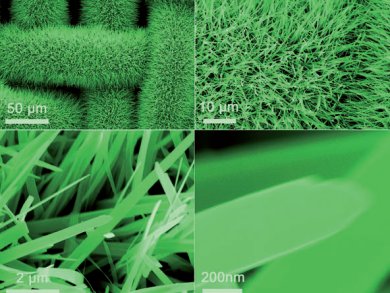Growing a 1D nanostructure directly on metallic substrates avoids complex recycling processes. This has been achieved with Fe2V4O13, which is often used to degrade organic pollutants.
Yong Zhou, Zhigang Zou, and co-workers, Nanjing University, China, report the synthesis of Fe2V4O13 nanoribbons that are directly grown on stainless-steel mesh (SSM) by a simple and hydrothermal reaction. The SSM serves as both the Fe source and the substrate for the deposition of vanadium and oxide elements.
The supported Fe2V4O13 nanoribbon, which can be easily recycled for photocatalytic application, shows great potential for the efficient photoreduction of CO2 into a renewable hydrocarbon fuel (CH4) and the removal of gaseous isopropyl alcohol from air under visible-light illumination.
- Direct Growth of Fe2V4O13 Nanoribbons on a Stainless-Steel Mesh for Visible-Light Photoreduction of CO2 into Renewable Hydrocarbon Fuel and Degradation of Gaseous Isopropyl Alcohol,
Ping Li, Yong Zhou, Wenguang Tu, Qi Liu, Shicheng Yan, Zhigang Zou,
ChemPlusChem 2013.
DOI: 10.1002/cplu.201200289



